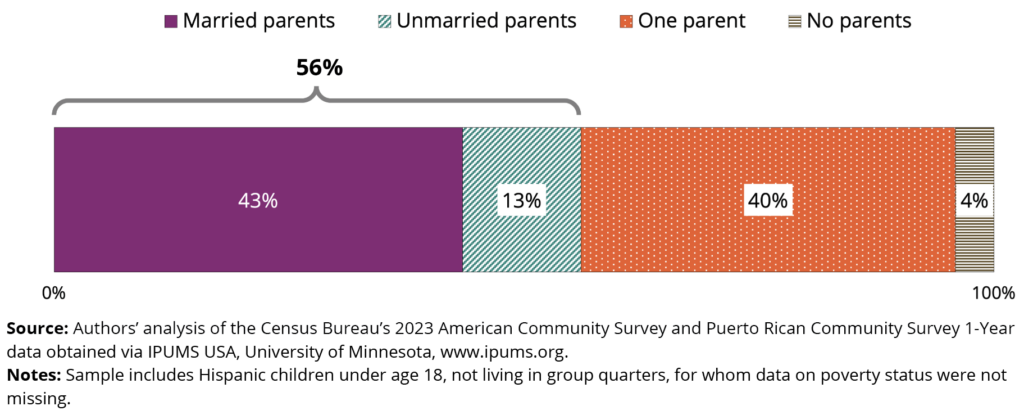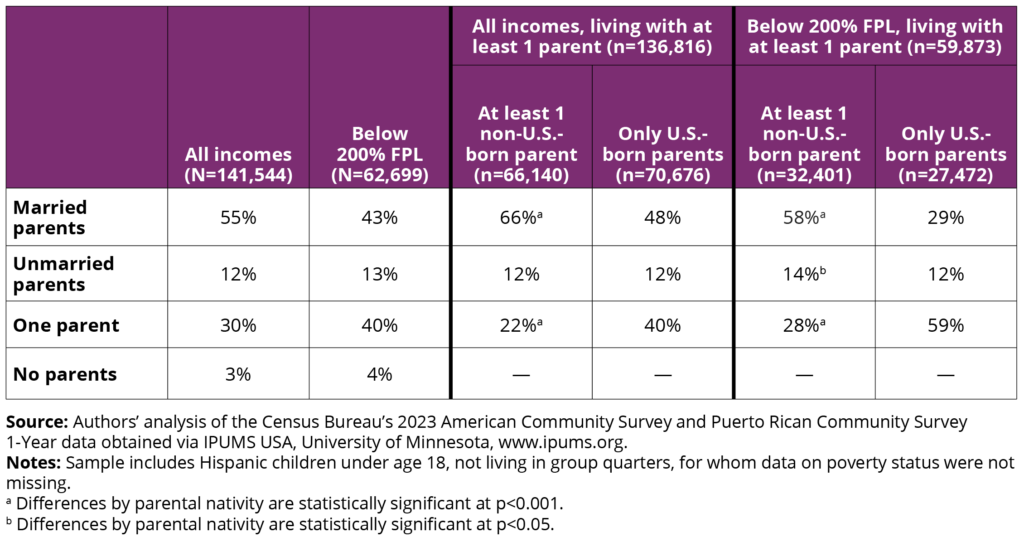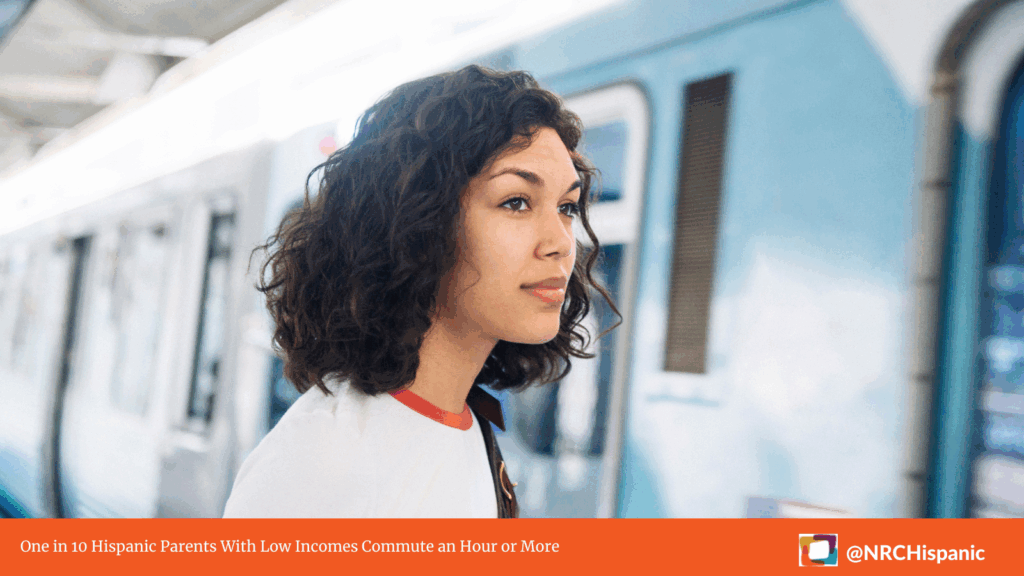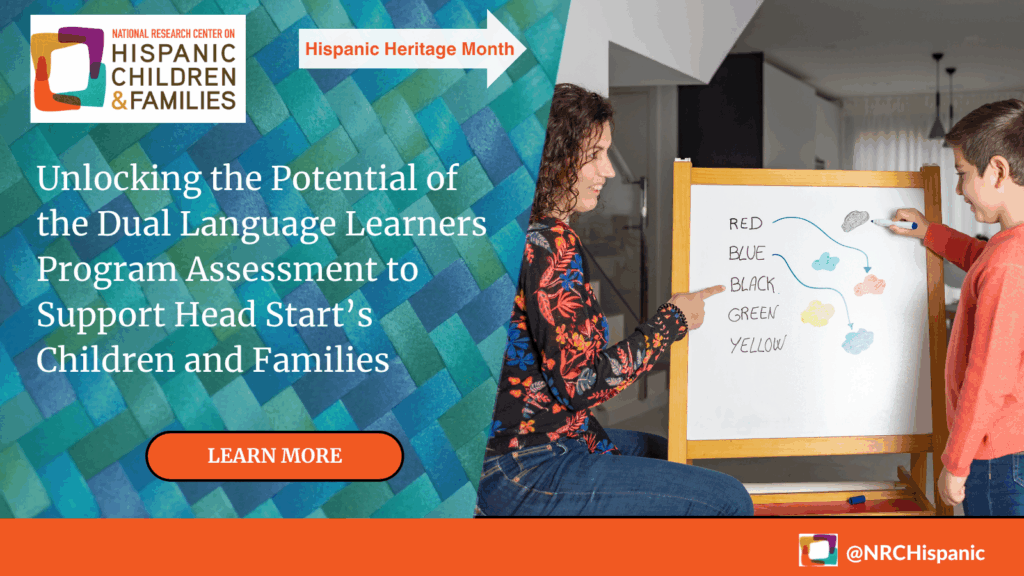Jun 11, 2025
Data Point, Hispanic Child and Family Facts
A Majority of Hispanic Children in Households With Low Incomes Live in Two-Parent Families
Authors:
The most common family structure among Hispanic children in households with low incomes is a married two-parent1 family (43%), according to our analysis of 2023 American Community Survey data. An additional 13 percent of these children live with two cohabiting parents. Combined, 56 percent of Hispanic children in households with low incomes live in two-parent families, with either married or cohabiting parents. Rounding out the portrait of family structures, we also find that 40 percent of Hispanic children in households with low incomes live in single-parent families and 4 percent live in some other type of family arrangement with no parent present (e.g., with a grandparent).
More than half of Hispanic children in households with low incomes live in a family headed by two parents, either married or cohabiting.
Percentage of Hispanic children in low-income households, by family type category
Hispanic children in households with low incomes who live with an immigrant parent(s) are twice as likely to have two married parents present (58%) as those who live with only U.S.-born parents (29%) (see Table A). Conversely, those who live with only U.S.-born parents are just over twice as likely to be in a single-parent family (59%) as those living with an immigrant parent (28%). Overall, irrespective of family income, 55 percent of all Hispanic children live in families with two married parents, 30 percent live with one parent, 12 percent live with two cohabiting parents, and 3 percent have no parent present in the household (see Table A).
How and when people form families has changed substantially since the middle of the last century—shifts occurring in response to large-scale economic, social, and cultural changes within the United States and around the globe. People are increasingly cohabiting (living with an unmarried partner), waiting longer to get married, and, in many cases, having children before they marry. Additionally, divorce rates increased over much of the 20th century, although they have declined somewhat in recent years. These changes have altered the structure of children’s families (i.e., the composition and relationships of the family members with whom a child lives) and have done so differently across race and ethnicity, immigration status, and socioeconomic status.
Families play an essential role in children’s healthy development and overall well-being. Although children can and do thrive in all types of families, family structure in the United States is closely associated with the economic resources and social and emotional supports a child can access. Single-parent families are more likely to have low incomes than two-parent families, so children in the former often have less access to benefits—such as higher-quality neighborhoods, schools, and health care—that come with higher family incomes. It is important to remember, however, that having two parents in the household does not mean that a family will be immune to periods of low income: As our analysis shows, in 2023, more than half of Hispanic children in families with low incomes lived with two parents. A wide range of human service programs are designed to support families with low incomes, including Temporary Assistance for Needy Families (TANF), Head Start, and child care programs subsidized by the Child Care Development Fund (CCDF). To best meet families’ needs, these programs should be aware of the varied living arrangements of the families they serve.
Methods
For this analysis, we used data from the U.S. Census Bureau’s 2023 nationally representative American Community Survey (ACS) and Puerto Rican Community Survey (PRCS) 1-year samples, obtained from IPUMS USA. We define Hispanic children as children under age 18 for whom a Latino, Hispanic, or Spanish origin was reported, regardless of race. Our analyses excluded Hispanic children living in group quarters, and those with missing poverty data, resulting in a full unweighted sample of 141,544 Hispanic children. For estimates of family structure by parental nativity, we further excluded cases with no parental nativity data, resulting in a subsample of 136,816 Hispanic children.
Our measure of family structure identifies children living with married parents, unmarried parents, one parent, or no parents. Parent identification derives from IPUMS’ identification of each household member’s mother and father, and includes biological parents as well as stepparents and adoptive parents. The marker also identifies second mothers and fathers among those with two mothers or two fathers. Data only includes parents living in the household (i.e., parents who may spend time with the child but live elsewhere are not included). Most children who do not live wither either parent are living with a grandparent or other relative. We used IPUMS’ attached characteristics feature to create an indicator of parent marital status for each household member. See IPUMS’ description of constructed family relationships for more detail.
We created the category of families with low incomes using the IPUMS-constructed poverty variable, which calculates each person’s family income as a percentage of their family’s poverty threshold (see this summary of the poverty measure in IPUMS). We also show estimates according to whether children’s coresidential parents were born in the United States (i.e., their nativity) using two categories: 1) at least one parent in the household was born in another country or 2) all parents in the household are U.S.-born. For children with only one parent in the household, parental nativity was assigned based on the nativity of that parent alone.
Table A. Family Structure of Hispanic Children, by key characteristic, for all family incomes and for families with incomes below 200% FPL.
Suggested Citation
Wildsmith, E., Alvira-Hammond, M. (2025). A majority of Hispanic children in households with low incomes live in two-parent families. National Research Center on Hispanic Children & Families. DOI: 10.59377/356a3056s
Footnotes
1 Includes biological, step, or adoptive parents.






